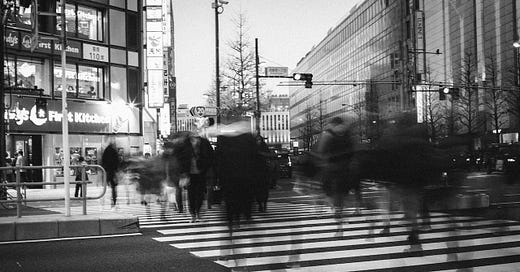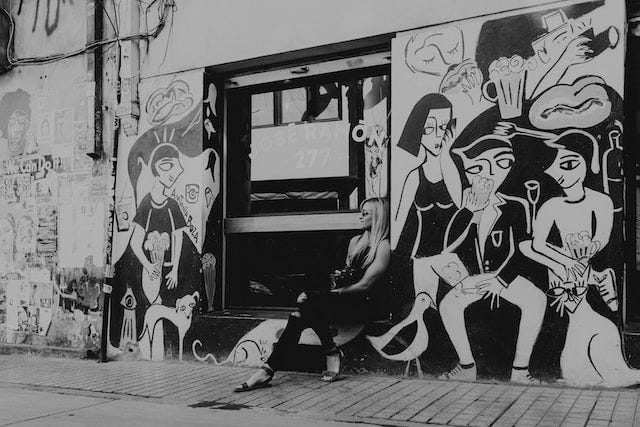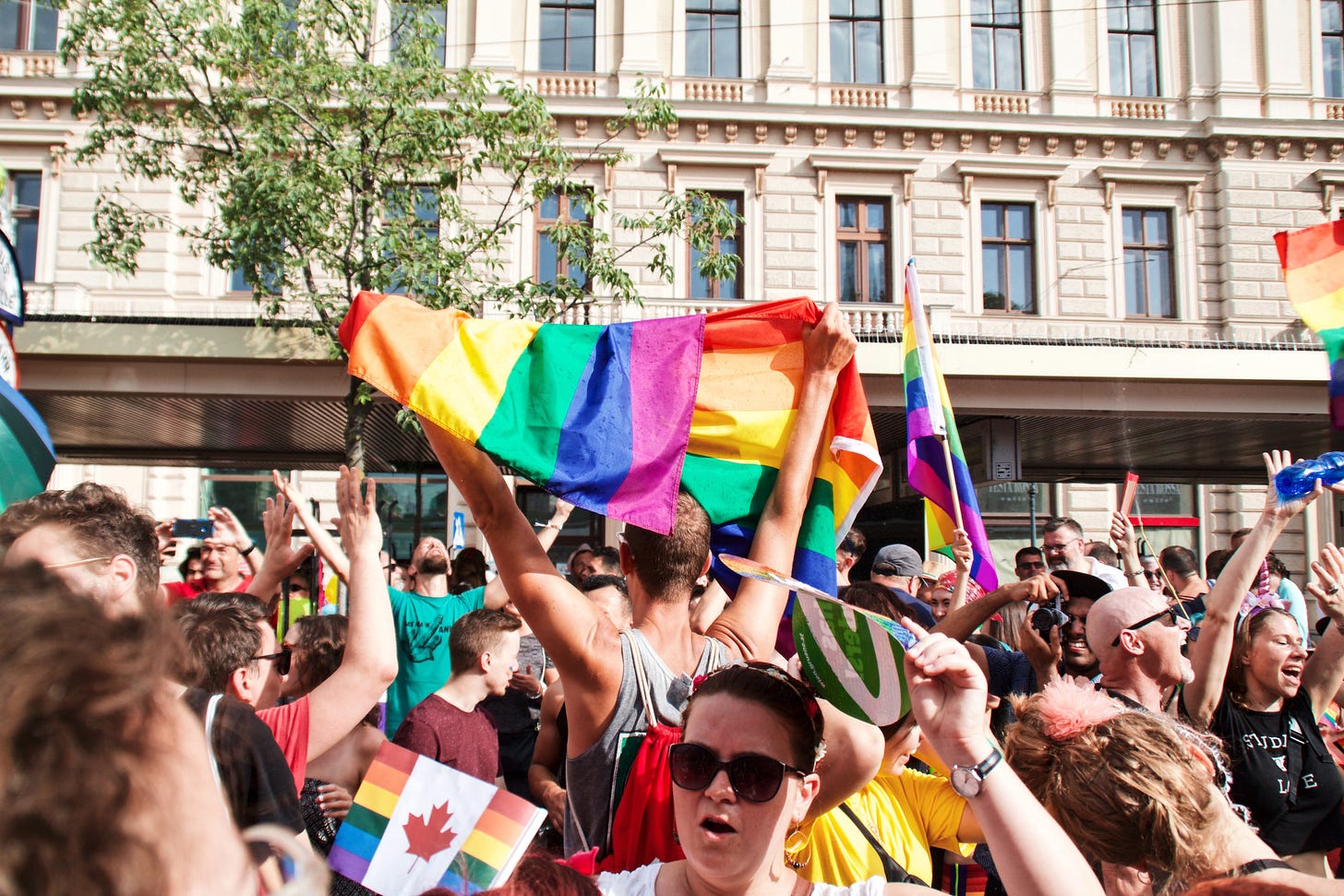Photo by Shawn Siew from Pexels
Welcome to A Narrative of their Own, where I discuss the work of 20th century women writers and their relevance to contemporary culture.
As the first anniversary of the newsletter approaches and with many new subscribers joining us here in the past few months, I decided to republish a couple of my favourite early posts over the summer. If you’ve been here since the early days - thank you! More new literary discussions are on their way :)
The term ‘flâneur’ originates from the Old Norse verb ‘flana’ from around the 16th or 17th century and literally means ‘to wander with no purpose’. It was popularised in early nineteenth-century Paris, where the earliest known representation in writing is an anonymous pamphlet of 1806.
The term was originally used to denote strolling or idling; essentially wasting time. Sometime in the 19th century, however, more meaning was attached to the term which came to represent male writers such as Baudelaire, who wandered the city and used the intense images he encountered within his writing. This term became synonymous with the modern idea of the writer and artist, at once immersed in, yet apart from, the busy urbanised environment of the city.
Within her wonderful book Flâneuse, Lauren Elkin introduces the idea that the female equivalent to this, the ‘flâneuse’, was often dismissed as a non-existent entity. Women on the streets of a city in the 19th and early 20th centuries were viewed with distrust, open only to female prostitutes or homelessness, and it was considered that a woman seen in the streets to be of questionable morals. This resulted in whole public spaces from which women were excluded or invisible.
As Elkin points out however, the more you look, the more evidence you find of such women writers and artists, who subverted respectable behaviour to take to the streets of the city in order to wander, wonder, and write about what they saw.
Unlike the flâneur, who could wander aimlessly as he pleased, the flâneuse wandered where she wasn’t supposed to wander. She transgressed, observed, and recorded the things she saw. She got to know the city streets intimately, often stealing back to her rooms to write down what she discovered there.
Virginia Woolf was one of the original flâneuse, penning an essay entitled ‘Street Haunting’, claiming that, as a woman enters the urban streets alone, she disposes for a while of the things that define her at home. Within the domestic sphere, the woman of the late 19th and early 20th centuries would have represented the centre of the family, drowned in the demands of a household, children and domestic duties. Out on the streets of the city, however, she became an invisible enquirer, slipping between the shadows of the bustle and buildings of the metropolis.
By engaging with the world beyond her doorstep, Woolf was able to tap into her surroundings and the people she encountered, inspiring her to create her famous title character Mrs Dalloway. The very first page of Woolf’s novel has the title character informing us: ‘I love walking in London. Really, it’s better than walking in the country.’ In this respect, not only is Woolf one of the original flâneuse, but she gives this quality to her central character, Clarissa Dalloway.
Within Elkin’s book, she discusses the proliferation of women writers whom she encounters as she herself becomes a modern day flâneuse, first in New York, then Paris. As the book progresses, we accompany her through Tokyo, Venice and London, as she experiences heart break and displacement, as well as intense joy at the discoveries she finds on the streets of the cities she inhabits.
Accompanying Elkin on her city walks are the women writers and artists who have gone before her.
In Paris, as a twenty-year old student, she first discovers Jean Rhys and her novels of lonely, displaced women wandering the streets of Paris and London. Rhys’ characters inhabit the streets of the city seeking male attention and protection, even though such streets are often dirty, unkind places. Seemingly though, she appears unable to let go of them, and they proliferate her work throughout her novels, finding fear and instability, yet also great excitement within them. In Rhys’ novel Voyage in the Dark, the narrator Anna Morgan reveals the coldness she feels upon arrival in London - both of the people and the climate. Yet it is to these streets that she returns, seeking excitement and experiences, even when they are unkind to her.
Perhaps for Rhys, the bustle of the city tempered the homesickness she felt at leaving her Caribbean home behind.
A writer I discovered more recently, Amy Levy, wrote of Jewish women’s experiences and the juxtaposition of beauty and violence in late 19th century London in her collection A London Plane Tree and Other Verse (1889). Levy’s poem ‘Confinement’ speaks of the country of her homeland as she compares herself to a caged bird, wondering whether if she were to return to her homeland now that she had assimilated into the urbanised culture of London, whether she would wish to be re-incarcerated back into her ‘cage’.
Levy, who was the first Jewish woman to attend Newnham College, Cambridge, wrote several novels as well as poetry and essays. Her first novel, The Romance of a Shop (1888) is often regarded as an early ‘New Woman’ novel popularised at the end of the 19th century, and covers such topics as the difficulties for women of running a business at the time. Her second novel Reuben Sachs (1888) allowed for a deeper literary dive into the issue of Jewish life and character which she had formerly discussed in essay form. The city at the turn of the century is central to both of these novels and much of her poetry, and clearly informed her ideas around feminism, Jewishness, and life in the city.
The flâneuse raises the idea of observing the city under a female gaze. As the first women to explore the city and all it had to offer, late 19th and early 20th century women writers represented the growing urbanisation of our cities and the people who inhabited them. By making themselves and their characters visible, and by showing the world through an uninhibited female gaze, they allowed for a female representation of the urbanity of the time, as well as how all kinds of women were seen and portrayed in these environments.
Photo by Persnickety Prints on Unsplash
But the city also offered a kind of freedom from the gaze for women writers, who found a way to slip between the cracks and report on the colourful lives of the inhabitants, raising the question, as Elkin puts it: ‘Do we want to attract or escape the gaze?’
I came to consider whether the city provided a sense of protection, anonymous amongst the citizens, or whether it was still considered a place of danger for women during the Covid pandemic, when women around the UK took to the streets to oppose political rhetoric around women’s safety. The suggestions arose following two brutal murders of young women, and sadly comments were raised about whether it was wise for women to allow themselves to be out in the city at night, and whether they should avoid public spaces such as parks, making them responsible for their own safety.
After years of moving away from such victim-blaming rhetoric, women risked arrest for gathering in the parks and walking the streets of the city. This sparked organised marches and vigils to honour the dead women, who had paid the ultimate sacrifice for what they had considered their human rights and freedoms.
The city has always been synonymous with the freedom to march and for activism, and I am thankful to live in a country which allows such peaceful protests to take place. From the splendour of the Pride marches during the summer to the recent protests against the increases in the cost of living, the city provides its citizens with the infrastructure to share their commonality with one another, or to remain anonymous if they choose.
Photo by Hannah Voggenhuber on Unsplash
It seems that just like the early 20th century flâneuse, women are still drawn to the city streets whether it be for anonymity and to simply observe, or to join with others. Whether like Levy, with her observance of the plane trees in the centre of the urban scrawl of London, or Woolf’s suggestions of leaving the domestic life behind, such images and sense of character of the urbanised environment made it into their work as it has continued to do so for many writers and artists since. Since the birth of the flâneuse, the city has represented a place of freedom for women, full of opportunity and somewhere to blend in with the crowd, as well as to report on it.
As Elkin pertinently asks: ‘Do we want to stand out, or blend in?’ For both the transgressive flâneurs’ she discovers on her own walks, and the contemporary women of now, it could be argued, a bit of both.
*Some portions of this essay, in a different format, first appeared in Longleaf Review.







Great essay! I love Woolf’s “Street Haunting.” It reminds me that for many flaneuse, an excuse was required to justify the walking. Like needing a pencil (or going to buy the flowers yourself). Women so often had to invent a reason for wandering, which couldn’t be wandering itself.